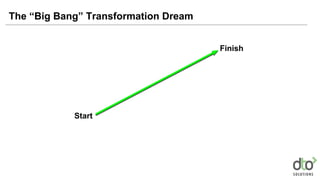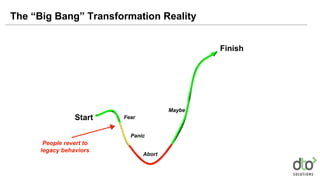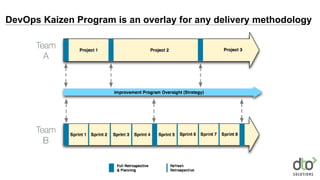DOES15 - Damon Edwards - DevOps Kaizen Practical Steps to Start & Sustain a Transformation
- 1. DevOps Kaizen: Practical Steps to Start & Sustain an Organization’s Transformation © DTO Solutions, Inc. Damon Edwards @damonedwards
- 3. High Performing CompaniesPractices & Behaviors Gene Kim … but WHY are they different?
- 4. The ability to improve.
- 5. The unique trait of high-performing companies is that they are good at learning fast.
- 6. Improvement already has a well known recipe: Plan - Do - Study - Act (PDSA) Other variants: PDCA OODA W. Edwards Deming - 1950 © The Deming Institute
- 7. 1. The work isn’t visible 2. People are working out of context 3. Inertia is pulling your org out of alignment Why are so many organizations unable to improve? (Silo Effects)
- 8. Org Charts Reference Architecture Strategy & Budget Strategy & Budget Documented Processes Project Plans Traditional “Visibility” For Technology Managers Release Trains Meetings Meetings Meetings Meetings Meetings Meetings Meetings Meetings Meetings Meetings Meetings Meetings Meetings Meetings Meetings Meetings
- 9. Complex System Complex System interacting with No wonder… 1. The work isn’t visible 2. People are working out of context 3. Inertia is pulling your org out of alignment It’s a complex system
- 10. The only way to fix a sufficiently complex system is to create the conditions for the system to fix itself.
- 11. Too costly… outsource more! Finance More discipline… tighter process and more approvals! Change Management We need results… re-org until we do! Executive Committee Need better tools… new automation and a new network! Engineers “I know the answer!…”
- 12. The “Big Bang” Transformation Dream Start Finish
- 13. The “Big Bang” Transformation Reality Start Finish Fear Panic Abort Maybe People revert to legacy behaviors
- 14. More discipline… tighter process and more approvals Need Results… Re-Org! Need better tools… cool automation and a new network!! Too costly… outsource more! Finance Change Management Executive Committee Engineers
- 15. How to teach an organization to fix itself: “Little J’s” instead of “Big J” Start Finish Start Finish “Big Bang” Continuous Improvement Fear Panic Abort Maybe
- 16. Turn Continuous Improvement into an enterprise program •Keep improvement efforts aligned •Scale quickly •Span multiple organizational boundaries •Work with substantial numbers of legacy technologies •Develop your existing staff in mass •Be self-funding after initial seed investment You are going to have to…
- 17. 1. The work isn’t visible 2. People are working out of context 3. Inertia is pulling your org out of alignment Remember what you are up against….
- 18. “DevOps Kaizen” • Kaizen: Japanese word for improvement • Modern business context: • Continuous improvement • Systematic, scientific-method approach • Total engagement of the workforce • Valuing small changes as much as large changes (outcome is what matters) • DevOps context: • Continuously improve the flow of work through the full value stream in order to improve customer outcomes
- 19. Proven Lean Techniques + DevOps Context “If I have seen further, it is by standing on the shoulders of giants.” -Sir Isaac Newton “DevOps Kaizen”
- 20. Elements of a DevOps Kaizen Program
- 21. Elements of a DevOps Kaizen Program
- 22. Organization-wide focus on service delivery metrics • Lead Time (Duration and Predictability) • MTTD (Mean Time To Detect) • MTTR (Mean Time to Repair, Mean Time to Fix) • Quality at the Source (Scrap/Rework)
- 23. Elements of a DevOps Kaizen Program This is where the work becomes visible!
- 24. Retrospectives are a per value stream tool Value Stream A Value Stream B Value Stream C Key: “horizontal thinking”
- 25. Map end-to-end process1 Include key process metrics: Lead Time Processing Time Scrap Rate Head Count DevOps Kaizen: Retrospective Technique Key: graphical facilitation above all else! Note: “go to the gemba” requires making it visible together Inspiration: value stream mapping
- 26. Identify wastes, inefficiencies, bottlenecks PD - Partially Done TS - Task Switching W - Waiting M - Motion / Manual D - Defects EP - Extra Process EF - Extra Features HB - Heroics Structured approach building on DevOps adaptation of “7 deadly wastes” from Lean / Agile: 2 DevOps Kaizen: Retrospective Technique Key: focus on flow of value… not gripes Inspiration: 7 Wastes of Software Development
- 27. DevOps Kaizen: Retrospective Technique Identify countermeasures Countermeasures must be actionable, backlog ready. Focus on short-term “baby steps”. Note broader, strategic recommendations. 3 Key: “small j’s, not big j’s”
- 28. DevOps Kaizen: Retrospective Technique Create Improvement Storyboards (Kata Style)4 Key: actionable short-term “baby steps”… “what are we going to do next?”
- 29. DevOps Kaizen: Retrospective Technique
- 31. + Work in small batches + Early Ops Involvement + Standardized Catalog (with design standards built-in) + Plan and Design by Those Who Will Do Key: “What can we do next?” NOT “what is nirvana?”
- 33. +Dev provide service verification tests +Ops provide environment verification tests (used by Dev and QA) +Self-service test data setup (including mainframe)
- 34. Improvement Storyboards Inspiration: A3 management process Template Example
- 35. Using Storyboards: Part Sales, Part Coaching Learner Coach / Leader What is the target condition? What is the actual condition now? What obstacles do you think are stopping you from reaching target condition? What is your next step? When will we know what was learned from the next step? Asks Questions Maintain Storyboard Answer / Explain Inspiration: Toyota Kata
- 36. Repeatable and Scalable Coaching Pattern Manages Value Stream (VP) Manages Value Stream Loops (Director, Managers) Implements Improvements (All) Sets Business Goal (CXO) Focused on... This is how the org learns fast!
- 37. Elements of a DevOps Kaizen Program
- 38. 1. The will to make change happen 2. The resources to make change happen 3. Follow-through / clear obstacles Kaizen Program Oversight This (and only this) is what the Kaizen Program Oversight Group does!
- 39. 1. The will to make change happen 2. The resources to make change happen 3. Follow-through / clear obstacles Kaizen Program Oversight Inspire Executives with:
- 40. Elements of a DevOps Kaizen Program
- 41. DevOps Kaizen Program is an overlay for any delivery methodology
- 42. DevOps Kaizen: Let’s Recap! Make the work visible Focus on Continuous Improvement Establish program elements Build into your operating model
Editor's Notes
- I’m a really lucky guy... I get to do a lot of things that give me inside access to seeing how some of the most interesting companies in the world run. Where they are succeeding, where they are failing, what their hopes and dreams are... Two main things I’m up to right now.
- doing a lot with Gene Kim lately great job cataloging capabilities high performance… version control, infrastructure as code, dev do deploys… But what is singular characteristic that is present in all high performers?
- Or I should say… “getting good at getting better”
- The unique trait of high-performing companies is that they are good at getting better. Why is that?
- Improvement is well known… it’s the scientific method taught in every grammar school.
- But is that what we do? NO OF COURSE NOT.
- THE SEARCH FOR THE SILVER BULLET… THE MAGIC FIX…. THEY ARE LOOKING AT THEIR ILLUSION OF CONTROL DOCUMENTS AND SAY “I KNOW HOW TO FIX THIS!”
- Everybody is holding on to the big bang transformation dream
- So what happens when you apply a big bang transformation project to a complex system where: The work isn’t visible People are working out of context Inertia is pulling your org out of alignment
- After enough years of seen the difference between companies who are good at getting better and those who are not… we’ve seen a common set of behaviors. We’ve been working on how to package it so that other companies can learn to work in this way.
- Every time felt like the first time
- How do you apply these?
- Facilitator roles… run ceremony and do analysis/coaching often different roles










































